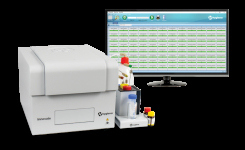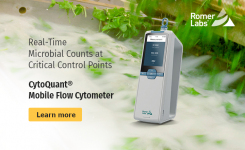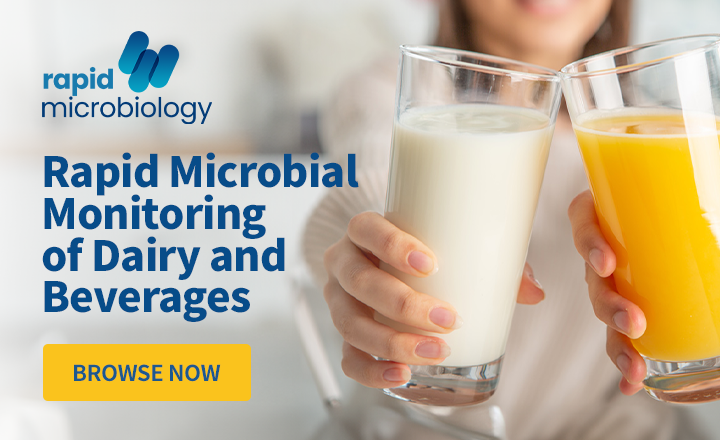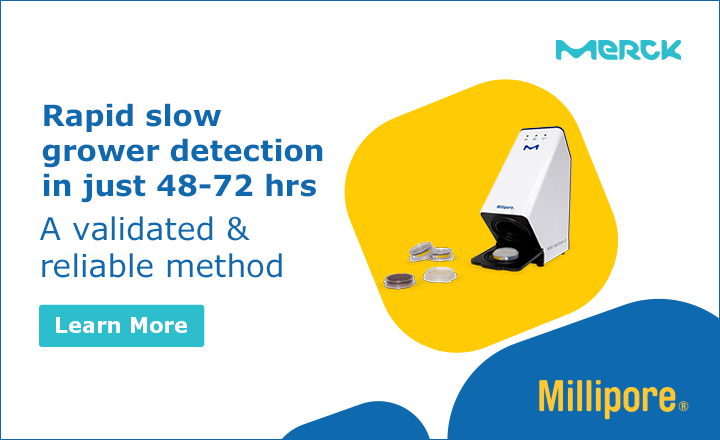
Key Points
- Mostly controlled by process design and HACCP based controls
- End product testing needs representative sampling
- Rapid methods should reduce pre-incubation step as well as the microbial detection stage
 The UHT process
The UHT process
Canned foods have a very long shelf life at ambient temperature because the heat process (appertization) is sufficient to destroy not only pathogens, but also any potential spoilage organisms that may be able to grow in the can's contents during storage. The end result is often referred to as 'commercially sterile' since the process is not designed to completely sterilise the food, but only to render it safe and microbiologically stable. Unfortunately, appertization processes can have a serious effect on the nutritional content and sensory characteristics of some foods. This is mainly because sufficient heat has to be applied to raise the temperature at the slowest heating point in the container - usually the centre - high enough to destroy heat resistant bacterial spores. In practice this means 121oC for a minimum of 3 minutes, resulting in overall process times often exceeding 20-30 minutes. Heat sensitive food components can be severely damaged under these conditions, reducing product quality considerably.
One solution to this problem is the ultra-high temperature (UHT) process, where foods are heated quickly to temperatures in the range 135-150oC for a few seconds and then cooled rapidly to ambient temperature. This has the same effect on the microbial population as a conventional canning process, but has much less effect on the sensory and nutritional qualities of the food, which are much more sensitive to the duration of the process than to increases in temperature. This idea has been around for almost a century, but only became practical in the 1940s and early 1950s when researchers in Switzerland combined UHT processing with aseptic filling so that the food could be heated very quickly in a suitable vessel and then cooled before filling into pre-sterilised cans. This process was too expensive to be a commercial success until 1961, when cardboard cartons replaced the cans. The first commercial product was UHT milk, but the process has since been applied to a wide range of other dairy products, baby foods, desserts, egg products, sauces, soups, fruit juices and soft drinks. Today, UHT processes can be applied in a number of different ways, including direct steam injection and indirect heating using heat exchangers designed to suit particular products. After processing the product is filled aseptically into a variety of packaging, including cardboard cartons, plastic bottles and foil pouches.
The role of microbiological testing The commercial sterility of the finished UHT processed product depends on excluding microbial contamination from two sources.
1. Heat resistant spores present in ingredients prior to processing, which may survive an inadequate process
2. Post-process contamination introduced into the product through packaging or a failure in the integrity of the aseptic filling system
In modern UHT food plants this is largely achieved by robust process design and by HACCP-based controls, rather than by routine microbiological testing of finished products. Nevertheless, commercial sterility testing does have an important role as a verification tool to demonstrate that the process and its controls are effective. This is especially true during the commissioning of new processing equipment, validation of new processes and in the development of new products. Microbiological testing at this stage can provide valuable data to support commissioning and validation procedures and help prove product and process safety.
Methods
The basis of current methods for commercial sterility testing is pre-incubation of samples in the final packaging, followed by detection of any microbial growth.
Sampling It is important that the samples tested are representative of a specific lot. A valid sampling scheme designed on sound statistical principles is essential. For example, it is possible that an equipment failure may allow contamination to enter the process at a late stage in a production run. Samples must therefore represent the full extent of the run to detect that contamination.
Pre-incubation The most sensitive and simple method of testing for commercial sterility is to incubate product samples in their final packaging at elevated temperature before examining them for evidence of microbial growth. Typically, samples are incubated at 30oC, although where thermophilic spoilage is a concern (e.g. for products exported to regions with a high ambient temperature), duplicates may also be incubated at 55oC. The incubation time depends to some extent on the nature of the product, but is likely to be within the range 4-15 days. For some foods, especially milk, there are legal requirements relating to sample incubation. For example, European Commission Regulation (EC) 2074/2005 states that a UHT milk treatment must be "sufficient to ensure that the products remain microbiologically stable after incubating for 15 days at 30oC in closed containers or for 7 days at 55oC in closed containers or after any other method demonstrating that the appropriate heat treatment has been applied." Although this implies that commercial sterility testing is likely to take more than two weeks to complete, it does not exclude the possibility of using other methods, provided that they can be shown to achieve the same result.
Microbial detection Following incubation, the product samples are examined for signs of microbial growth. This may be immediately apparent if gas-producing species have multiplied and caused the packaging to swell. These 'blown' packs should be carefully opened and subcultured onto suitable media so that the contaminating organisms can be identified. If the packs appear normal their contents should be checked for microbial growth by plating out onto appropriate non-selective agar media. This can be done using a spread plate method, or by direct inoculation using a calibrated loop to deliver an inoculum of 0.1 ml. Duplicate plates should be incubated under aerobic and anaerobic conditions for 48-72 hours and then examined for visible colonies. A microbiologically stable product should normally contain less than 100 CFU/ml after pre-incubation.
Rapid Methods
Testing for commercial sterility by pre-incubation of samples and culture-based microbial detection is both time consuming and labour intensive, with little opportunity for automation. It may take almost three weeks to confirm a negative result, which can act as a considerable bottleneck, especially during product and process development trials. It is no surprise therefore that rapid methods have been widely investigated as a means of reducing this delay. Most of this effort has been focused on the microbial detection step, but some methods also have the potential to reduce the pre-incubation time necessary before growth becomes detectable.
ATP-bioluminescence One of the most widely used rapid methods for detection of contamination in UHT products is ATP-bioluminescence. By using a luminometer to detect light produced from microbial ATP in a reaction catalysed by the enzyme luciferase, it is possible to detect quite low levels of microbial cells in the sample, provided that it can be pre-treated with reagents designed to reduce background levels of non-microbial ATP in the sample. The method can be used as a presence/absence test for screening large numbers of UHT treated food and beverage samples after a considerably reduced pre-incubation time. For example, the Celsis Rapid Detection System claims to reduce testing times from up to 14 days to just 48 hours, delivering considerable cost savings. Test protocols for a wide range of food products have been developed and validated successfully and the system is said to be simple to operate. ATP-bioluminescence is also the basis for the 3M™ Microbial Luminescence System (MLS) and the Promicol ATP Detection Kits, both of which can be used to screen UHT-treated food products for contamination using reagents designed specifically for the purpose.
Other rapid methods A different approach to microbial detection is at the heart of the automated Soleris™ system supplied by the Neogen® Corporation. This provides early detection of contamination by utilising an LED and a photo detector to monitor colour changes caused by bacterial growth in a specially designed vial containing a growth medium and colour indicators. The vial is inoculated with a sample dilution and as bacteria grow they produce changes in pH and other biochemical indicators leading to a colour change in the vial. The instrument monitors each vial and records the time taken to produce a detectable colour change, which is related to the initial microbial count. A protocol for sterility testing has been developed for the food industry.
Cytometry-based methods can be used to screen UHT products. The AES Chemunex BactiFlow® ALS Real Time Analyzer uses a fluorescent labelling technique to detect viable cells directly in liquids by flow cytometry. The technique is relatively sensitive and has the potential to reduce the pre-incubation time of samples significantly. It can be applied to a range of non-filterable liquid food and beverage products and a protocol for sterility testing of UHT products has been developed for food manufacturers.
BioLumix , now part of Neogen, have developed a method for the early detection of organisms in UHT samples The system utilizes a Carbon dioxide sensor since it is a universal metabolite produced by all microorganisms. A disposable test vial contains a transparent solid sensor located at the bottom of the vial that changes color whenever CO2 diffuses due to microorganism growth. Only gases can penetrate the sensor that blocks liquids, microorganisms and particulate matter. The carbon dioxide generated by microbial metabolism diffuses into the sensor and reacts with a reagent to provide indication of the presence of the gas. This type of vial is used for sterility testing and for yeast & mold. The BioLumix system is capable of quickly distinguishing clean UHT samples from samples containing bacteria, yeast or molds with a high degree of accuracy.
High sample volumes can be tested in the Oculer Rapid 930 Series system, where up to 10 ml of sample can be added directly to a vial containing an oxygen sensor, respiration of any organisms present will cause depletion of oxygen which is monitored by the instrument. Savings are made not only in the faster result but also due to elimination of the need for media preparation.
Get the latest updates in Rapid Microbiological Test Methods sent to your email? Subscribe to the free rapidmicrobiology eNewsletter























